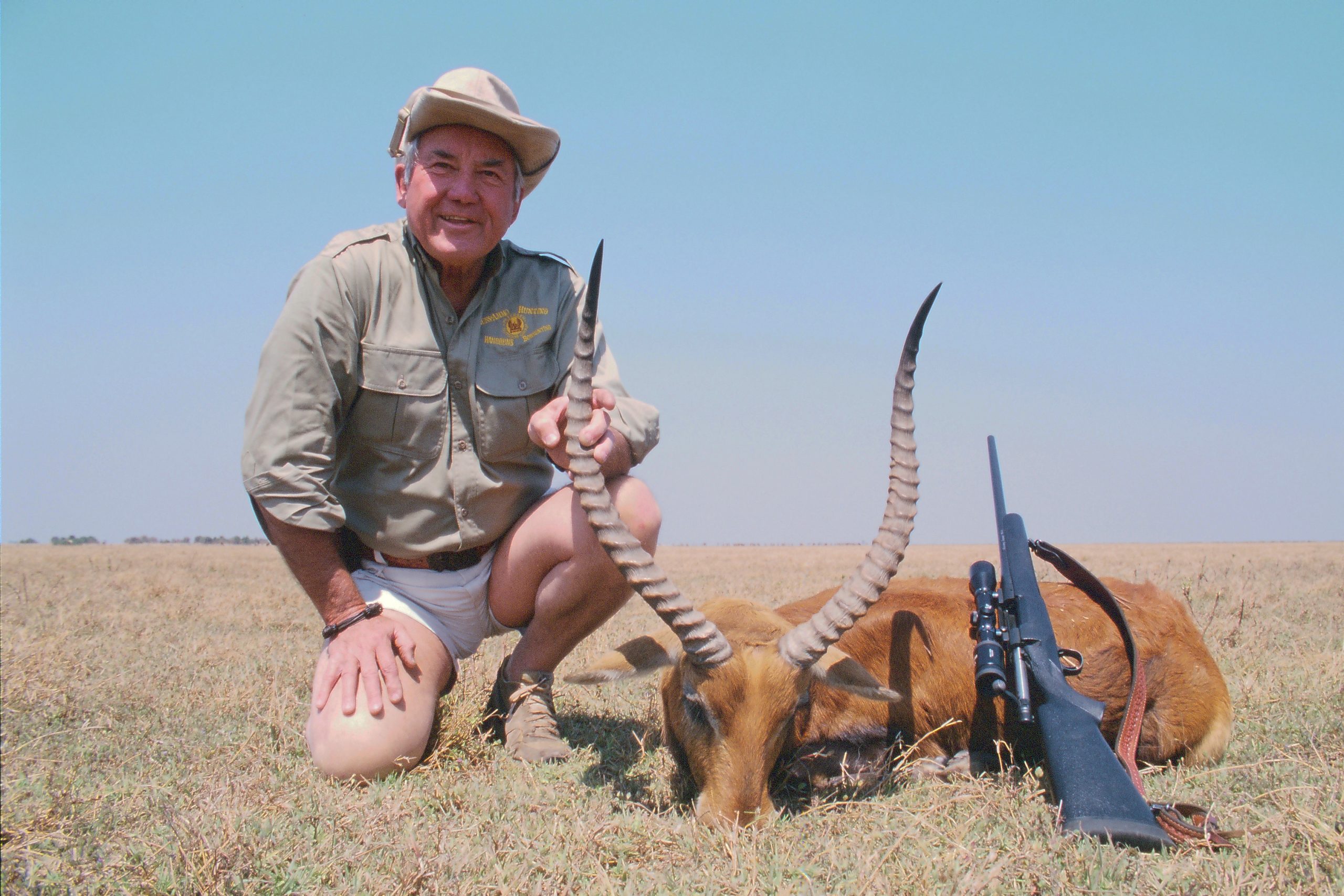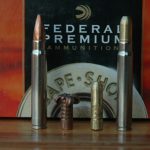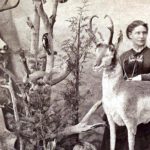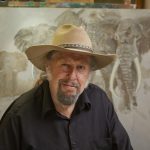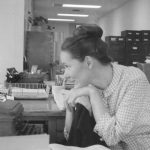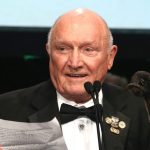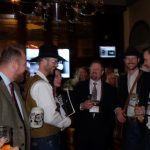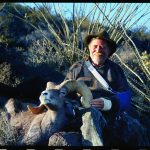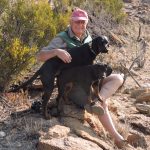Craig Boddington honors one of his heroes, Robert “Pete” Petersen, during a special hunt in New Mexico.
Photo above: Robert E. “Pete” Petersen with a fine lechwe taken in Zambia.
Living legends are so rare that not all of us will encounter even one. It’s probably more unusual when the legend turns out to be 100 percent genuine. Robert E. “Pete” Petersen (1926-2007) was the real deal. Mr. Petersen, as I called him, made a business and a fortune from his passions– cars, guns, and hunting. He is perhaps best known for the Petersen Automotive Museum, and for his publishing empire. Many of the magazines he launched still bear his name. It’s not as well-known that, after the final sale of Petersen Publishing Company (and within minutes of the expiration of his non-competition clause), Pete was also the owner and custodian of this time-honored title, Sports Afield, which he managed for a two-year period together with his friend and long-time right hand, Ken Elliott (1940-2019).
As his business became successful, Pete could have any firearm he wanted, and his gun collection was amazing; after his death, a large portion of it went to the NRA, with some of the highlights on display. But there was collecting, and there was hunting; in the field Pete rarely used ornate firearms from his collection, relying instead upon old friends he trusted. To celebrate the sale of his company and his seventieth birthday in 1996, Pete went on safari to Zambia, and Ken Elliott and I joined him there, together with Pete’s ranch manager, Gary Williams, and renowned wildlife artist Doug Van Howd. Pete had a .22 Hornet; he almost always took a Hornet to Africa. For larger plains game he had a .300 Jarrett. For buffalo he had his old standby, the wildcat .460 G&A by George Hoenig. Ken had a .460 G&A Short built by Jack Lott, and his .257 Weatherby.
Among many common interests, Ken and Pete were both quarter-bore fans. Although he didn’t take it on that trip, one of Pete’s pet rifles in later years was a thumbhole-stocked rifle John Lazzeroni built for him. It was chambered to the ultimate .25-caliber, Lazzeroni’s 6.53 (.257) Scramjet, fastest its class, pushing a 100-grain bullet at 3700 feet per second.

At this point in his life Pete could hunt anywhere he chose, but he wasn’t a collector. He appreciated nice animals, but he loved most the pursuit, and there was no ranking in his mind. He loved hunting ducks and valley quail, and he’d crawl through the California chaparral on hands and knees shooting ground squirrels. He used that Scramjet to take several spectacular pronghorns and deer on his ranch. Regrettably, Pete suffered a series of health issues, and he never returned to Africa after that 1996 hunt.
Some time after Pete’s passing, John Lazzeroni saw a couple boxes of 6.53 (.257) Scramjet ammunition for sale on the internet at a good price. On delivery, he was shocked to discover it was ammo he’d loaded for Pete, with “Loaded for Robert Petersen” on the end flaps. That sparked an idea. John Lazzeroni likes thumbhole stocks. I do not but, after all, how many left-handed thumbholes have I seen? A wrong-sided thumbhole is almost impossible to use! So, “Lazz” built me a thumbhole Scramjet identical to the one he’d made for Pete, the idea being that Ken Elliott, Lazz, and I, all sharing serious hero worship for Bob Petersen, would go hunting with Pete’s ammo, and raise glasses in his honor.

Great idea, but Ken was dealing with the cancer that would eventually kill him. We discussed hogs in California or something in Texas, but Ken couldn’t travel, and in late 2019 we lost him. By now we’d delayed the planned hunt for years, and then came the pandemic lockdown. In the spring, as things started to open up, Lazz said he knew of some feral hogs in southern New Mexico. Perfect! I was planning on driving to Phoenix to see my daughter; Lazz lives in Tucson, so I could swing down, and we could socially distance our way over to New Mexico.
Mind you, I was skeptical; there are many unknown pockets of feral hogs, but I’d not heard of any in New Mexico. As we neared the target area, I got even more suspicious, because the dry Southwest terrain didn’t look like hog habitat. But, sure enough, it was real. The population is neither widespread nor large, but there were pigs. We found them in brush around huge irrigation pivots, wallowing in wet spots and living in disconcerting harmony with cattle, something I’ve never seen before.
I insisted John have first shot with Pete’s ammo and “his” rifle. We glassed a couple of boars near a shallow waterhole and managed a stalk on a hot afternoon, the pigs snoozing away next to the cool mud. We got pretty close, but the depression was so shallow and the pigs were so comfy that there wasn’t anything to shoot at. Busting them out wasn’t an option, because there were cattle behind, so we had to watch the shot angles and use the depression as a backstop. The best course was to wait them out, which kept Lazz ready on the rifle in hot sun for a long time, one of those deals where I was very happy it was his shot!
The depression was deeper than it appeared, and there was a third boar that we hadn’t seen. We had a strong wind in our faces, but one big spotted boar got nervous. We lost him in an unseen furrow, and then he stuck his head up. The Ballistic Tip was still going Mach III when it entered at the base of his ear. Pete would have been proud of his cartridge and the shot.
Using other Lazzeroni cartridges, we shot another big boar that evening, and a couple more the next day. Lazz had a full-size freezer hooked up in his truck, able to be plugged in overnight. We skinned and quartered the pigs at the ranch headquarters, and by the time we got back to Tucson, the meat was frozen.

But the point of the hunt was, and is, to honor Bob Petersen, so let me tell you a couple of things about the Chief. Pete was smart, tough, and fair, a wonderful guy to work for. Hot Rod magazine was his first, printed in his garage, and he passed it out at local races. When the Korean War broke out, Pete was in the Air Force Reserve and had orders to report. His business was just starting to take off and he figured this would be the end of it; he had his duffel packed and was on his way when his orders were cancelled.
By the time the first Gulf War erupted, Petersen Publishing was a large company, with all the trappings. But there was no policy covering what the company would do if an employee was called to active duty. No reason there should be–at that time, there hadn’t been a reserve callup for forty years. Bob Petersen established the policy himself. I was the only employee activated, and Petersen Publishing took good care of my family. Pete told me he figured that, if his orders to Korea had gone through, Petersen Publishing Company would not have happened, and he never forgot. I’ll never forget, either!
During the years I worked at Petersen’s ,I did some bird hunting with Pete, and some prairie dog shooting, which he loved. But until the Zambia trip I’d never hunted big game with Pete. Early on, I’d been warned: “If you ever go hunting with the Chief, do not shoot a bigger animal than he does . . . or you’re finished around here!” I had no way to know if this was true, but it was accepted as an article of faith. After all, I was just one of a couple dozen magazine editors, so our relationship, though friendly and comfortable, was respectful and professional.
We flew into Lusaka in the morning and chartered to Bangweulu, arriving just after lunch. We had divvied up licenses; only Pete and I had sitatunga permits. PH Austin Wienand suggested we drop our gear quickly, get organized, check rifles, and go to machans. Pete had a sore knee, so they put me in a pole blind some distance in the swamp, Pete in another closer to the edge. I doubt if I’d been in the blind an hour when a huge sitatunga stepped out of some papyrus. I shot without hesitation—it was a great bull. Then I realized: Pete was unlikely to see one this size, so I’d just committed career suicide! Worse, by the time we recovered the animal it was almost dark, so I was keeping the Chairman of the Board waiting in the evening chill, swatting hordes of mosquitoes.
When we got back to the truck, with my sitatunga slung on a pole, Pete was waiting with a flashlight, wanting to see it–and he was soon lying in the mud, happily taking pictures. “Turn the horns just a bit. Wait, let me get one more!” I was not in trouble–far from it!–and that legend was pure BS. Bob Petersen was a real hunter, and he loved every minute of it–win, lose, or draw. He would have gotten a huge kick out of John Lazzeroni’s “pandemic pig hunt.”

